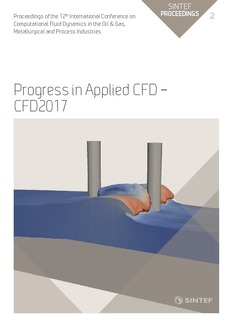| dc.description.abstract | In Fluid Phase Resonance (FPR) mixers, a central pipe reaches into the liquid phase inside a mixing vessel. Thus two closed gas cushions are formed above the liquid – one inside the pipe and one above the liquid inside the vessel. A drive attached at the top of the pipe creates low frequency (typically in a range from 1 s-1 to 5 s-1) harmonical pressure oscillations in the gas cushion inside the pipe, which in turn induce a motion inside all the liquid in the vessel. This motion of the liquid is utilised for the purpose of mixing and dispersion of particles. Simulations are performed for four different geometries of the central pipe's lower exit and for different particle Stokes numbers. Particle Stokes numbers are varied from 9.7·10-4 to 2.7 by changing the particle diameter and density. The flow field inside the vessel was simulated with a Volume-of-Fluid solver to capture the free surface and the influence of the gas cushions, which act like springs, until a quasi-steady state was reached. One of these simulations was verified with Laser Doppler Anemometry measurements. For each simulation, the flow fields of the last full oscillation period are stored. The particles are then repeatedly tracked through these flow fields for 15 oscillations with an Euler-Lagrange approach with oneway- coupling, so that there is no need to recalculate the flow fields. The particles are considered as point masses, which are exposed to added mass, buoyancy, drag, gravity, history, pressure gradient, rotational lift, and shear lift force. Hydrodynamic torque is also considered, as well as a Langevin model for turbulent dispersion and a wall collision model accounting for rotation. Mixing quality and time are determined by means of correlation dimension and the 90% lifting criterion whereby one of the four pipe exit configurations was identified as the best one. For this configuration two more oscillation frequencies are also investigated. Increasing the frequency to the resonance frequency leads to a more intense mixing process. Increasing it further drastically reduces the fluid velocity and deteriorates the mixing properties. Furthermore, the influence of the different forces on the particles is investigated. The often neglected added mass and history forces are quite relevant for all particles investigated, having always more than 10% of the drag force’s magnitude, with maximum values of up to 142% for added mass and up to 66% for history force. Pressure gradient force is highly relevant for larger particles. The rotational lift force is important for large particles only. Finally, the shear lift force is highly important, especially for larger and denser particle, but negligible for small, light particles. | nb_NO |
